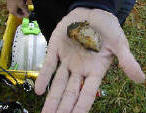Cave Formations
Windows to the Past, by Matt London
Speleothems
‘Speleothems’ are those icicle like rock formations that ornament the inside of many caves throughout the world. Sometimes referred as “dripstones” or just simply “cave formations”; speleothems are comprised of secondary mineral deposits (Moore 1952) and can grow into a variety of shapes and sizes.
Although more than 250 cave minerals are known to form a speleothem’s inner core (Hill & Forti 1997) most commonly they are comprised of the minerals calcite, aragonite, or gypsum that was first dissolved from primary mineral bodies such as the bedrock that encases the cave in a process known as “dissolution”.
Dissolution
Dissolution is caused by a naturally occurring carbonic acid produced by rainwater mixing with the highly acidic soil and groundwater at the “soil zone”. The soil zone is the layer of earth closest to the surface where rapidly decaying plant, animal and insect remains can produce large amounts of carbon dioxide (CO2). Carbon dioxide contents in the soil zone can be in excess of 300 times the level found in the outside atmosphere!!!
Carbon dioxide rich soil at the soil zone mixes with rainwater to produce a mild form of carbonic acid, which attacks (dissolving trace amounts into solution) any calcite based permeable limestone or other similarly based mineral laying in it’s path.
When this calcite/C02 rich rainwater encounters an air filled cave (which normally contains a much lower carbon dioxide partial pressure contents then the acidy calcite/C02 rich rainwater dripping through the ceiling) it’s carbon dioxide content immediately rushes to leave the calcite rich rainwater solution (see “Henry’s Law”) depositing a trace amount of the calcite it holds onto the cave. Gradually over some period of years (drop by drop) a stalactite or other cave formation begins to appear and grow.
This can also help explain why carbon dioxide levels within some dry cave passages can sore while oxygen content can drop substantially drops.
Warning note: always Keep your Regulator in your Mouth!
Do not breath the air from dry pockets found in some submerged caves around Thailand unless you know for a fact that it is safe to do so! Over a period of time oxygen content in “cave air” can be displaced by C02. – Oxygen levels below 16% can cause loss of consciousness and below 10% even death!
Rate of Development
In general caves in colder or more arid climates tend to have less, smaller or even in some cases no speleothems at all! That’s simply because there is less carbon dioxide produced in the soil zone in colder climates due to a lack of decaying plant, animal and insect remains etc to produce .
In contrast when the soil zone contains a thick warm organic blanket of fertile soil, like in many parts of tropical Thailand, carbon dioxide levels increase substantially creating a mild form of carbonic acid that interacts with the limestone layer below. As the dissolution process increases so does cave formation growth rate inside the air filled cave below.
What about in Thailand?
In Thailand an annual “cycle” of speleothem development can be observed in two parts. In the cool dry season there is less rain and less plant, animal and insect remains decaying, so carbon dioxide content in the soil is much lower then during the warmer rainy season when cave formation growth is considerably accelerated.
Can Speleothems provide clues?
The distinctive growth rings of the speleothem’s inner core are similar in appearance to the growth rings of a tree trunk and can provide scientists with a sequential form of data on a variety of topics such as climatic and environmental conditions during formation and perhaps even give us more clues in understanding and hopefully rectifying the so called “Greenhouse Effect” or perhaps provide additional clues on the subject of “Global Warming”.
 Inner cores of cave deposits can provide scientists with valuable information on past weather conditions during various phases of development.
Inner cores of cave deposits can provide scientists with valuable information on past weather conditions during various phases of development.
History Revealed
Extrapolating information from dripstone core samples can be achieved through the use of modern scientific procedures such as measuring radioactive decay. This and further advancements are making it more and more possible to accurately determine the date, outside (surface) temperature range and other environmental conditions or factors present during it’s formation.
 This cave deposit sample, now blackened and heavily corroded by re-solution, was recovered from -55m and dated to between 30 – 35,000 years.
This cave deposit sample, now blackened and heavily corroded by re-solution, was recovered from -55m and dated to between 30 – 35,000 years.
The sequential type information provided by cave formations could actually help assist in broadening mankind’s understanding of the relation between the various biologic and geologic processes that have been shaping our planet and its inhabitants since the dawn of time!

